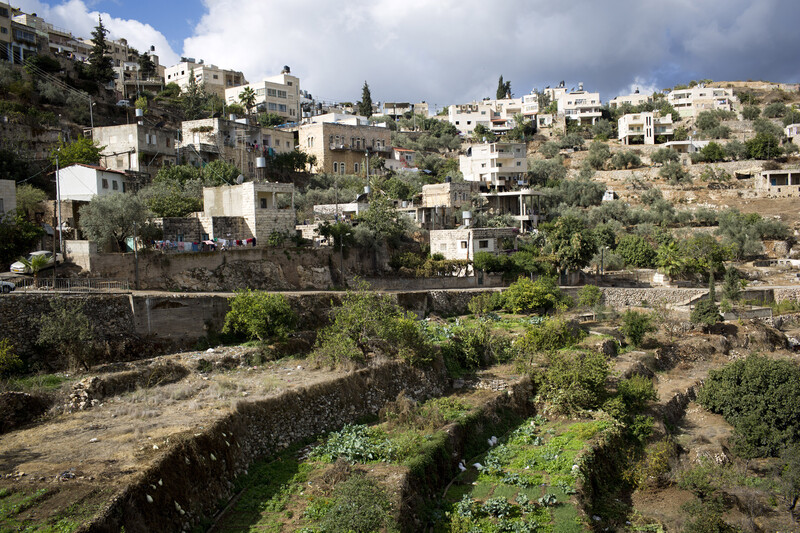Rights and Accountability 18 June 2014

The planned route of Israel’s wall would irreversibly destroy the landscape of Battir.
ActiveStillsUpdate (20 June 2014):
Today, 20 June, the Palestinian village Battir, located in the occupied West Bank, was inscribed on UNESCO’s World Heritage List and on the List of World Heritage in Danger. The designation affords it new protection from Israel’s bulldozers which threaten to destroy the village’s unique agricultural landscape.
The UN body stated today:
The World Heritage Committee today began the examination of 36 sites nominated for inclusion on the World Heritage List. The first property discussed was Palestine: Land of olives and vines, Cultural Landscape of Southern Jerusalem, Battir, submitted by Palestine as an emergency nomination.
The Committee approved the inscription of the site on the World Heritage List. It also inscribed the property on the List of World Heritage in Danger after finding that the landscape had become vulnerable under the impact of socio-cultural and geo-political transformations that could bring irreversible damage to its authenticity and integrity, citing the start of construction of a separation wall that may isolate farmers from fields they have cultivated for centuries.
Original post follows:
The Palestinian Authority and dozens of distinguished professionals in the fields of law, archaeology and Arab studies are appealing to the UN cultural organization UNESCO to urgently list the Palestinian village of Battir in the occupied West Bank as a World Heritage Site.
The intervention comes as the UN body’s World Heritage Committee convenes for its annual session in Doha over the next week. The Palestinian Authority’s emergency nomination of Battir will be reviewed under the committee’s special procedure applied to sites under serious threat.
The village of Battir’s extensive centuries-old, hand-built stone terraces and irrigation systems dating back to pre-Roman times would be irreversibly destroyed if Israel’s planned construction of its annexation wall on village land moves forward. The wall would also cut off village residents from one-third of their farmland.
The defense ministry’s proposed wall route in Battir is currently being challenged in Israel’s highest court. Critics of the defense ministry plans include the Israel Nature and Parks Authority, which has in other cases played a role in the theft of Palestinian land.
The route of Israel’s wall in the occupied West Bank was declared illegal by the International Court of Justice in 2004. When completed, the wall will effectively annex 46 percent of the West Bank to Israel. Palestinian civil society groups have declared July a month of action against the wall to mark the tenth anniversary of the International Court of Justice ruling.
Last year the World Monument Fund, an international organization dedicated to preserving cultural heritage sites around the world, placed Battir on its 2014 Watch List.
In a communication to the UNESCO World Heritage Committee, more than fifty esteemed professionals including individuals representing the University of Virginia School of Law International Human Rights Law Clinic and the Boston University School of Law Human Rights Clinic state:
“International UNESCO World Heritage recognition may be the only mechanism able to persuade Israel not to interfere with the people and their land. Not only does the village of Battir and its cultural landscape independently feature ancient human-made relics, the living history of its people deserves heightened protective status and recognition.”
The full communication with signatories can be read on the Jadaliyya website.
“Heavy price”
In an op-ed published last year by The Electronic Intifada, Hasan Abu Nimah describes the unique beauty of Battir, his birthplace:
The village is built on two high mountain slopes that face each other at an angle. The lower part of both slopes is made up of beautifully terraced orchards that village people used over the centuries for planting all kinds of vegetables where irrigation from the village spring was possible, or summer fruit trees that did not need irrigation.
Out of a large assortment of vegetables the “Battiri eggplant” has been distinguished worldwide for its taste and quality, and throughout Palestine and Jordan its name is known. In 2011, Battir won the 2011 Melina Mercouri Prize from UNESCO, the United Nations Educational, Scientific and Cultural Organization, for its “cultural landscape.”
He also recounts how the bustling economic life of the village, located on the historic Palestine railway connecting Jerusalem to the coast and further to Egypt, was disrupted with the ethnic cleansing of Palestine that began in 1947, and during which the railway stopped operating and the station was destroyed.
Abu Nimah, like other village residents, temporarily fled the constant fire until a 1949 truce was declared. However, he recounts, “As the armistice lines were delineated there was a trick, for which Battir is paying the heavy price 65 years later.”
Abu Nimah adds:
At the time, and because most of the Palestine railway from Jerusalem to the coast was under Israel’s control, except for the Battir sector, a proviso was included in the Jordan-Israel armistice agreement allowing Israel to extend the armistice line 200 yards east, within unoccupied village land, to run parallel to the railway line, on the grounds that that was necessary to provide security protection for the railway which Israel intended to use.
The village inhabitants were assured that they would not be separated from their farming land and houses including the school which fell behind the barbed wire on the Israeli side. That overlapping worked well — with some tragic incidents — until 1967 when the entire West Bank was occupied. The barbed wire, which was built across the village in 1949, did not last long and soon disappeared. The Israelis never restored it.
Apparently it did not disappear as an established practical fact, and the Israelis are now using it as grounds for building the separation wall. If the wall plan continues, it will destroy the village as many world reports warn. It will destroy the physical as well as the human character of a community that lived in peace and harmony for centuries.
UNESCO, Palestine and Israeli colonialism
While it may halt Israel’s bulldozers in Battir, not even World Heritage Site status with UNESCO fully protects Palestinians and their culture, as residents of Akka’s old city have learned.
The iconic walled old city of Akka, located on the coast of present-day Israel, was declared a World Heritage Site by the UN agency in 2001. But residents currently face eviction orders served by state-owned housing management companies in what Palestinians say is a bid to push them out of their property to make way for Jewish residents — a phenomenon underway in remaining Palestinian population centers in present-day Israel.
This week’s consideration of the Palestinian Authority’s emergency appeal is not the first time UNESCO has been a forum for diplomatic struggle over Palestine.
The United States government cut off funding to UNESCO after the agency admitted the Palestine Liberation Organization as a member state in 2011, and has since lost its voting rights at the body. The US was previously the biggest financial contributor to UNESCO, providing 22 percent of the agency’s annual budget. Israel, which suspended dues at the same time as the US, also lost its voting rights last year.
Ironically, cables released by Wikileaks show that in 2010, Israel attempted to overcome its diplomatic isolation by asking the US for assistance in placing an Israeli candidate for an assistant director-general position at UNESCO.
These efforts did not bear fruit, and when UNESCO voted to admit Palestine to the body, a move which Israel vehemently opposed, there were 107 votes in favor, 52 abstentions and only 14 dissenting votes.
“Museum of Tolerance” controversy
More recently, the New York City-based Center for Constitutional Rights and the Campaign to Preserve Mamilla Jerusalem Cemetery called on the State of Palestine’s representative to UNESCO earlier this month to take urgent action “to oppose UNESCO’s relationship with the Simon Wiesenthal Center (SWC) and to urge UNESCO to preserve what remains of Mamilla Cemetery in Jerusalem.”
The intervention concerns a Paris exhibition which UNESCO co-organized and is currently co-hosting with the Simon Wiesenthal Center, despite the center’s desecration of an ancient and venerated Muslim cemetery in Jerusalem. The Paris exhibition, originally slated to open in January, was postponed after protest by Arab member states at UNESCO.
The Simon Wiesenthal Center is building a controversial “Museum of Tolerance” on the cemetery, which has “already resulted in the secretive removal of thousands of human remains during excavations and infrastructure work,” the Center for Constitutional Rights states.
The status that the Simon Wiesenthal Center enjoys at UNESCO “blatantly contradict[s] the humanistic values that UNESCO stands for,” the Center for Constitutional Rights states, adding that the UN agency’s involvement in the exhibition “contributes to the perception that UNESCO is validating the SWC’s uprooting of Mamilla Cemetery in the Holy City of Jerusalem, an action which seeks to erase the long and deep history of Muslims and Palestinians in the same land.”





